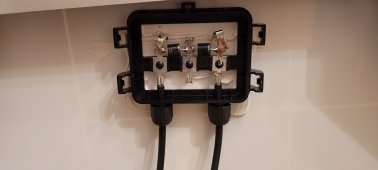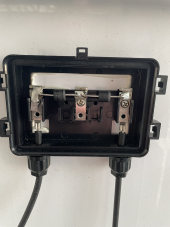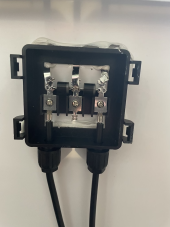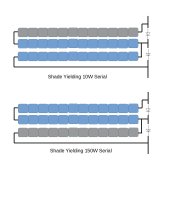I was just looking at extending the PV array on my trailer to use three panels and was considering whether to wire the panels in series or parallel. I had seen all sort of posts making claims both ways - serial is better because it boosts voltage and allows charging under low-light conditions - parallel is better because shade on a panel takes out the entire serial array.
But as has been pointed out here, modern panels all have bypass diodes because, well, electrical engineers are clever and know that shade exists (I checked on 9 different common manufacturers and all of them had bypass diodes - in fact, some manufacturers have gone a step further with half-cut panels). These bypass diodes effectively remove strings of shaded cells from the panel which prevents them from dragging down power production. The other factor is that PV cells reach their nominal Voc with very little light - about 200 W/m2 from the literature I can find online - so even shaded cells quickly reach their nominal Voc which eliminates most of the concerns about low-voltage scenarios.
So I took my two new Renogy 100W panels, a Victron 100/20 MPPT and a depleted battery plus an 80W fan to act as a load. Wired everything up and then ran shading tests to see how much power the was actually delivered to the load under seven different shading conditions with the panels wired in series, and then repeated the tests for the panels wired in parallel. The reason for seven test cases for each configuration is that the bypass diodes impose a structure on the 36 PV cells in the panel, so it matters which combinations of cells are shaded. In the case of the Renogy panels, it was a bit odd because while the panel has 36 PV cells (arranged in 3 columns) there are only 2 bypass diodes and the diodes are not associated with the same number of PV cells. One bypasses 12 cells (Column A), and the other bypasses 24 cells (Columns B & C). Hence, the 7 test cases are as follows (note - shading was only applied to one panel in the array - the other panel was always left completely unshaded):
What I found was that the shaded performance was about the same for both serial and parallel configurations in all 7 shade scenarios. This is what one would expect with the bypass diodes plus the fact that PV cells reach their nominal Voc levels with even small amounts of light. Since shade is low-light, not no-light, the shaded cells still seemed to reach their nominal Voc which prevents much of the power loss that a parallel array would see if any panel's output voltage were to drop below the others. Consequently in both configurations usable power correlated roughly with how many strings of cells were unshaded (as the bypass diodes effectively removed strings that were shaded) and therefore total current varies with the number of unshaded strings of cells but not Voc.
There is one scenario that I've not tested yet, which is to see how much power is actually available to the load over the course of an entire day. The interesting edge case is the low-light conditions seen and dusk and dawn - something < 200 W/m2. In principle, serial arrays would continue to generate enough voltage to turn on the MPPT charger where as the parallel array would not (the Victron MPPT manual points out that Vpv > Vbat + 5V in order to turn on the charger, and Vpv > Vbat + 1V to keep the charger turned on - so if the array is not generating sufficient voltage levels the power coming from the array will not actually make it to the load). However, this edge condition only occurs for a short period of time each day, and the panels are not generating that much power to begin with during those periods, so it is unclear to me whether this represents a significant factor in terms of watts-per-day that are delivered to the load.
I was going to post the measurements here, but when I repeated the tests with the panel order reversed, I got different results. This made me suspicious as it almost seemed like the bypass diodes in one of the panels were not working. So I popped open the wiring box on the panel that seemed to be misbehaving and, sure enough, it was missing one of its PV connections! See the attached picture - notice that the middle connector is not actually connected to the panel...
So, word to the wise, when buying new panels, check to see that the bypass diodes are actually wired correctly because apparently even well known companies like Renogy get it wrong sometimes...
Once I get the replacement panel, I will re-test and post the results. I think the results I saw when I was shading the non-defective panel are correct, but I want to ensure that I have two properly constructed panels before I post results.
But as has been pointed out here, modern panels all have bypass diodes because, well, electrical engineers are clever and know that shade exists (I checked on 9 different common manufacturers and all of them had bypass diodes - in fact, some manufacturers have gone a step further with half-cut panels). These bypass diodes effectively remove strings of shaded cells from the panel which prevents them from dragging down power production. The other factor is that PV cells reach their nominal Voc with very little light - about 200 W/m2 from the literature I can find online - so even shaded cells quickly reach their nominal Voc which eliminates most of the concerns about low-voltage scenarios.
So I took my two new Renogy 100W panels, a Victron 100/20 MPPT and a depleted battery plus an 80W fan to act as a load. Wired everything up and then ran shading tests to see how much power the was actually delivered to the load under seven different shading conditions with the panels wired in series, and then repeated the tests for the panels wired in parallel. The reason for seven test cases for each configuration is that the bypass diodes impose a structure on the 36 PV cells in the panel, so it matters which combinations of cells are shaded. In the case of the Renogy panels, it was a bit odd because while the panel has 36 PV cells (arranged in 3 columns) there are only 2 bypass diodes and the diodes are not associated with the same number of PV cells. One bypasses 12 cells (Column A), and the other bypasses 24 cells (Columns B & C). Hence, the 7 test cases are as follows (note - shading was only applied to one panel in the array - the other panel was always left completely unshaded):
- No Shade - should be 100% power
- Shade on Column A - should be about 83% power (60 out of 72 cells)
- Shade on Columns A & B - should be about 50% power (36 out of 72 cells)
- Shade on Columns B & C - should be about 67% power (48 out of 72 cells)
- Shade on Column C - should be about 67% power (48 out of 72 cells)
- Shade on the bottom 4 rows (covers 3 cells in columns A, B & C) - should be about 50% power (36 out of 72 cells)
- Fully Shaded (all cells, all columns) - should be about 50% power (36 out of 72 cells)
What I found was that the shaded performance was about the same for both serial and parallel configurations in all 7 shade scenarios. This is what one would expect with the bypass diodes plus the fact that PV cells reach their nominal Voc levels with even small amounts of light. Since shade is low-light, not no-light, the shaded cells still seemed to reach their nominal Voc which prevents much of the power loss that a parallel array would see if any panel's output voltage were to drop below the others. Consequently in both configurations usable power correlated roughly with how many strings of cells were unshaded (as the bypass diodes effectively removed strings that were shaded) and therefore total current varies with the number of unshaded strings of cells but not Voc.
There is one scenario that I've not tested yet, which is to see how much power is actually available to the load over the course of an entire day. The interesting edge case is the low-light conditions seen and dusk and dawn - something < 200 W/m2. In principle, serial arrays would continue to generate enough voltage to turn on the MPPT charger where as the parallel array would not (the Victron MPPT manual points out that Vpv > Vbat + 5V in order to turn on the charger, and Vpv > Vbat + 1V to keep the charger turned on - so if the array is not generating sufficient voltage levels the power coming from the array will not actually make it to the load). However, this edge condition only occurs for a short period of time each day, and the panels are not generating that much power to begin with during those periods, so it is unclear to me whether this represents a significant factor in terms of watts-per-day that are delivered to the load.
I was going to post the measurements here, but when I repeated the tests with the panel order reversed, I got different results. This made me suspicious as it almost seemed like the bypass diodes in one of the panels were not working. So I popped open the wiring box on the panel that seemed to be misbehaving and, sure enough, it was missing one of its PV connections! See the attached picture - notice that the middle connector is not actually connected to the panel...
So, word to the wise, when buying new panels, check to see that the bypass diodes are actually wired correctly because apparently even well known companies like Renogy get it wrong sometimes...
Once I get the replacement panel, I will re-test and post the results. I think the results I saw when I was shading the non-defective panel are correct, but I want to ensure that I have two properly constructed panels before I post results.
Attachments
Last edited:








